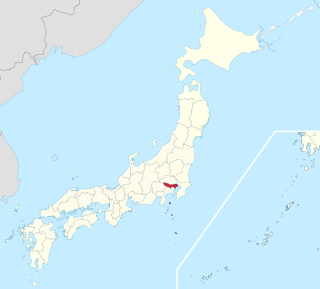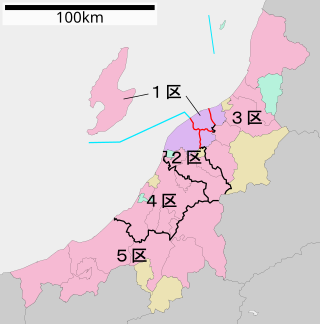
The National Diet is the national legislature of Japan. It is composed of a lower house, called the House of Representatives, and an upper house, the House of Councillors. Both houses are directly elected under a parallel voting system. In addition to passing laws, the Diet is formally responsible for nominating the Prime Minister. The Diet was first established as the Imperial Diet in 1890 under the Meiji Constitution, and took its current form in 1947 upon the adoption of the post-war constitution. Both houses meet in the National Diet Building in Nagatachō, Chiyoda, Tokyo.

The Japanese political process has two types of elections.
Makoto Hirayama is a Japanese politician. He served in the House of Councillors in the Diet from 2009 until 2013.

Gunma At-Large District is a constituency of the House of Councillors in the Diet of Japan. It consists of Gunma Prefecture and elects two Councillors, one per election.
The Kanagawa at-large district is a constituency of the House of Councillors in the Diet of Japan represented by six Councillors. It comprises the entire prefecture of Kanagawa and elects three Councillors every three years by single non-transferable vote.

Tokyo at-large district is an electoral district of the House of Councillors in the National Diet. The district was created in 1947 by the new Constitution of Japan and sent 8 members to the House from 1947 until 2007. From 2007 until 2016, this district sent 10 members to the House, and from 2016 onwards, the district has sent 12 councillors to the House, making it by-far the largest constituency in the House of Councillors

Tochigi At-Large District is a multi-member district of the House of Councillors in the Diet of Japan. It consists of Tochigi Prefecture and elects two Councillors, one per election.
The Hokkaido at-large district is a constituency of the House of Councillors in the Diet of Japan. It consists of the prefecture (dō) of Hokkai[dō] and is represented by six Councillors electing three at a time every three years by single non-transferable vote for six-year terms. In the election period from 2019 to 2022, Hokkaido's Councillors are :

Kagawa at-large district is a constituency of the House of Councillors in the Diet of Japan. It consists of Kagawa Prefecture and elects two Councillors, one every three years by a first-past-the-post system for a six-year term. In the first election in 1947, Kagawa like all districts used single non-transferable vote to elect both its Councillors in one election.
The Hyogo at-large district is a constituency that represents Hyogo Prefecture in the House of Councillors in the Diet of Japan. It currently has five Councillors in the 242-member house, but this representation will increase to six by July 2019.
The Tottori at-large district was a constituency that represents Tottori Prefecture in the House of Councillors in the Diet of Japan. Councillors are elected to the house by single non-transferable vote (SNTV) for six-year terms. Since the establishment of the current House of Councillors electoral system in 1947, the district has elected two Councillors, one each at elections held every three years. With its 474,963 registered voters it is the smallest electoral district for the house. Accordingly, a 2015 revision of the Public Officers Election Law will see the district merged with the Shimane At-large district to create the Tottori-Shimane At-large district; this change took effect at the 2016 election, at which one Councillor was elected.
The Tokushima-Kochi at-large district is a constituency of the House of Councillors in the Diet of Japan. The district was formed in 2015 from a merger of the Tokushima and Kōchi at-large districts. Liberal Democratic Party member Yusuke Nakanishi was elected as its first representative at the House of Councillors election in July 2016.

Ehime at-large district is a constituency of the House of Councillors in the Diet of Japan. It represents Ehime Prefecture and elects two Councillors, one every three years by a first-past-the-post system for a six-year term. In the first election in 1947, Ehime like all districts used single non-transferable vote to elect both its Councillors in one election. It has 1,169,427 registered voters as of September 2015. As a predominantly rural district, it has favoured the Liberal Democratic Party (LDP) candidate in most elections.
The Yamagata at-large district is a constituency that represents Yamagata Prefecture in the House of Councillors in the Diet of Japan. Councillors are elected to the house by single non-transferable vote (SNTV) for six-year terms. Since the establishment of the current House of Councillors electoral system in 1947, the district has elected two Councillors, one each at elections held every three years. It has 937,920 registered voters as of September 2015.

Saga at-large district is a constituency that represents Saga Prefecture in the House of Councillors in the Diet of Japan. Councillors are elected to the house by single non-transferable vote (SNTV) for six-year terms. Since the establishment of the current House of Councillors electoral system in 1947, the district has elected two Councillors, one each at elections held every three years. It has 679,289 registered voters as of September 2015.
The Shizuoka at-large district is a constituency that represents Shizuoka Prefecture in the House of Councillors in the Diet of Japan. It has four Councillors in the 242-member house.
The Kyoto at-large district is a constituency that represents Kyoto Prefecture in the House of Councillors of the Diet of Japan. It has four Councillors in the 242-member house.

Niigata 1st district is a constituency of the House of Representatives in the National Diet of Japan, represented by Chinami Nishimura of the Constitutional Democratic Party of Japan since 2017. As of 2017, 439,968 eligible voters were registered in the district
Kagoshima at-large district is a constituency in the House of Councillors of Japan, the upper house of the Diet of Japan. It currently elects two members to the House of Councillors, one per election.

House of Councillors elections were held in Japan on 10 July 2022 to elect 125 of the 248 members of the upper house of the National Diet, for a term of six years. The elections occurred after the assassination of Shinzo Abe on 8 July 2022. The elected candidate with the fewest votes in the Kanagawa prefectural district will serve for three years, as the district combined its regular and byelections.














